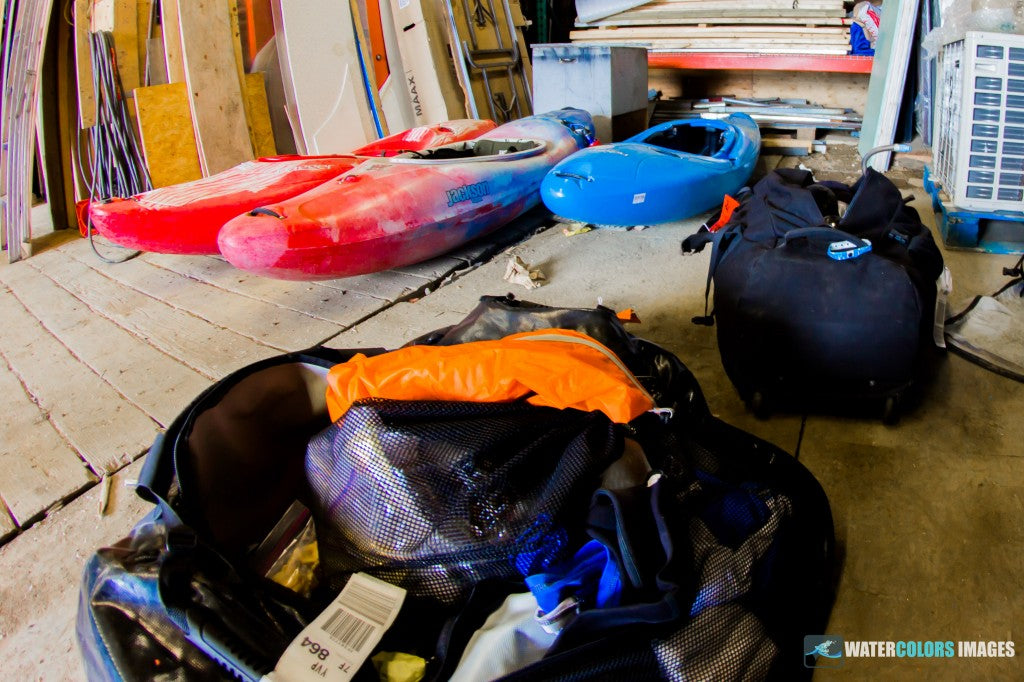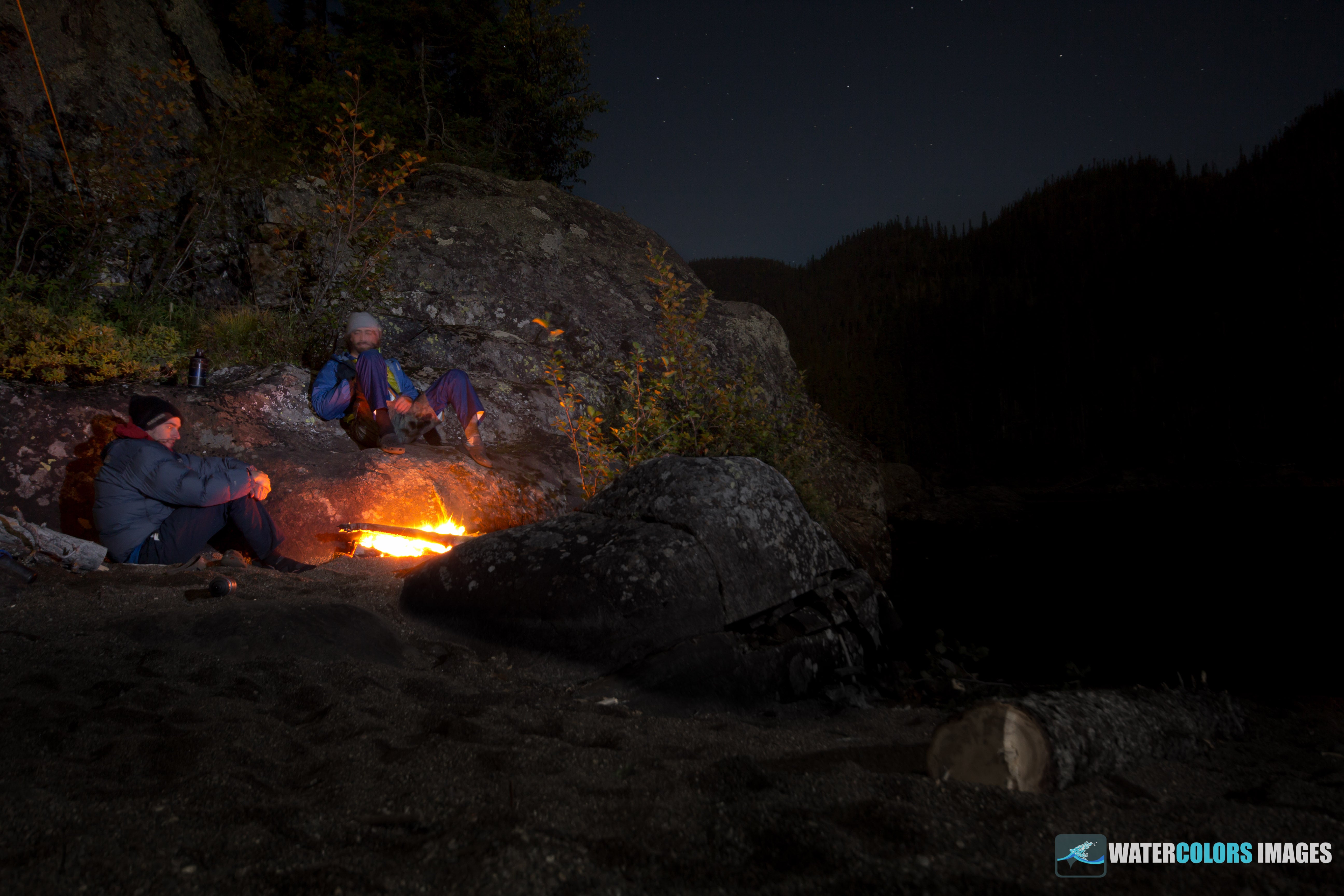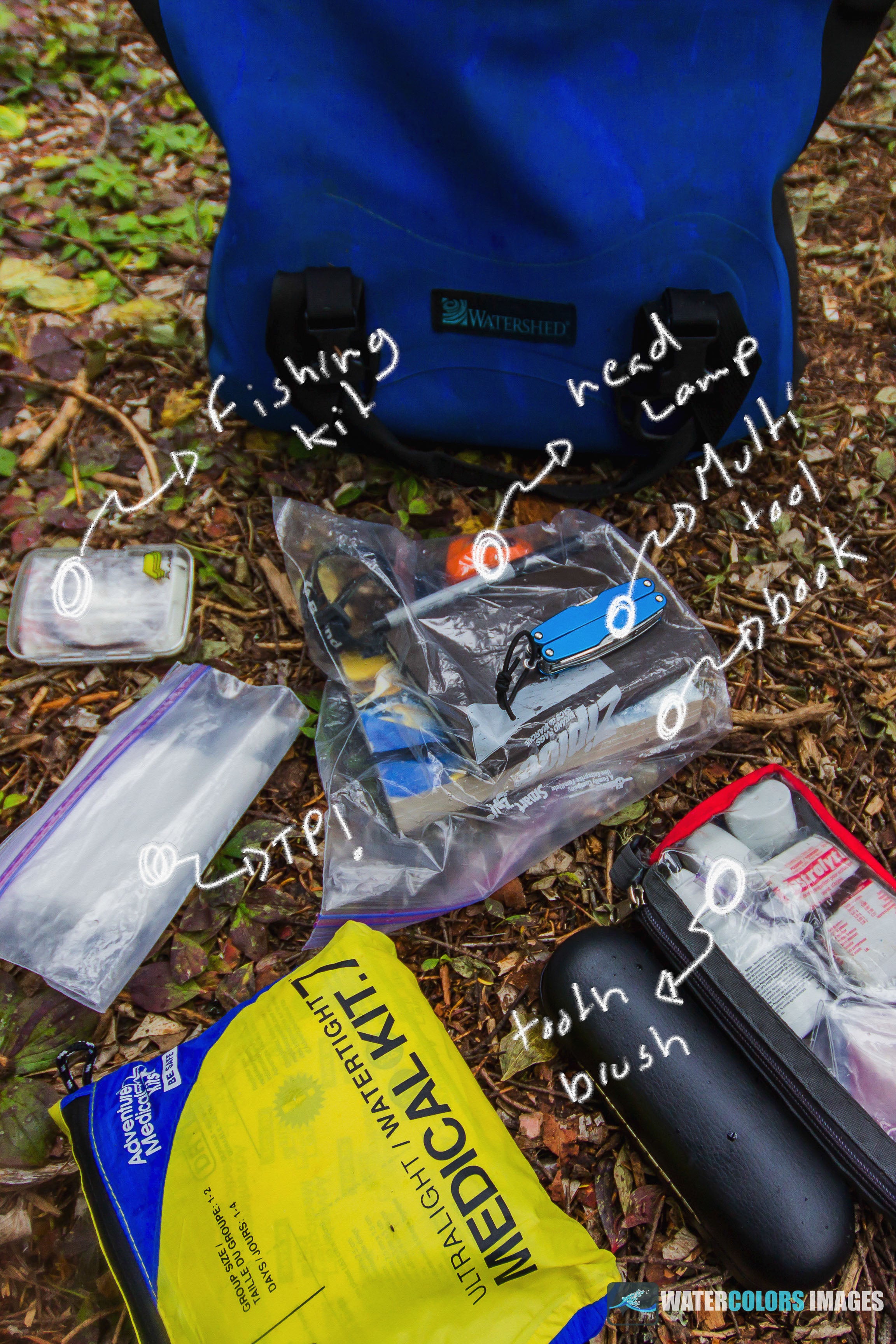Expedition Kayaking: What to Pack?

Packing for a whitewater kayaking expedition is always tricky and can have serious consequences on your trip, from being overloaded, cold or going hungry... When I first tried to pack my life into my boat , I searched the internet for a good guide on the subject of whitewater expedition paddling, and couldn't find anything. Most articles didn't relate to our cold Canadian climate or failed to explain the basics of gear selection for more than one night. So, here is my take on it!
First of all you need to break your needs into different groups: 1) paddling gear; 2) night time gear; 3) safety gear and 4) food and water. The second step is to do some research on the climate and weather of the region that you are launching in. Be careful most wilderness weathers tend to switch quite quickly from hot and sunny to cold and wet in the matter of hours, and especially in northern Canada. Prepare yourself for the worst scenarios and not only the best case
Paddling gear:
Paddling gear: Warm synthetic under layers will help keep you dry and warm on the river. The Level Six Hot Fuzz one piece suit is great for that purpose. Then, make sure you choose your clothes accordingly, better too warm then cold! Here in the "North", a drysuit is a must have item on an expedition. The Emperor Drysuit works really well on keeping you dry, warm and comfortable throughout the trip. Shoe selection is also important, I tend to choose a comfortable and rigid sole that will be safe during hikes or portages. Booties are not the best item to protect and cover your feet from the elements and wares of walking long distances. Follows, the usual paddling gear, a PFD, an helmet, a skirt and a paddle. Bring gear that you know works for you and that you've used before. I normally also bring a pair of sunglasses with a safety strap, in order to keep them on my face even when rolling. Selecting a boat can also be tricky. I would suggest taking a boat that you are used of paddling in normal conditions. Your boat also need to have sufficient volume to support your weigth but also the 40-50 lbs of gear that you'll be packing into it. The Dagger Nomad 8.5 is my prime choice, because it's the boat I normally paddle, but also because of the ease of access to the stern and numerous tie downs that you'll find in the 2013 outfitting. Removing the stern pillar will help to increase your interior storage space without compromising too much the overall structural integrity of the boat.

Night time gear: Once off the river, you want to be able to keep warm, dry and also sleep tight in order to have sufficient energy for the up coming day. I usually bring a set of underlayers for the night and/or sleeping in colder conditions. These have to remain dry in order to help keep you warm. Add to this a pair of light pants, a fleece, a synthetic or down insulated layer and a Goretex shell. Crocs or flip flops are a good choice for the off river time they are lightweight and don't absorb water when left in the bottom of your boat. Depending on the time of the year, you may also want to bring a warm hat and a pair of gloves. Sleeping is one of the most important factor in the success of expedition paddling. Being well rested will help you take better decisions and remain safe during the whole trip. So, I tend not to under evaluate my needs at this point. I normally bring a lightweight tent, not a bivy because most of the time they don't breath well and you wake up wet from the condensation. Good tents are both lightweight and pack into small spaces. The MSR Hubba, Mountain Hardwear SuperMega UL and Big Agnes Fly Creek are all good choices. If the region you're setting out in doesn't have mosquitos and normally dry weather, a tarp can also be a good alternative. I would recommend bringing 1 tent per person and a tarp for the group, for cooking and chilling in wet weather. Mattresses come in various shapes and sizes, choose something that will insulate you from the cold ground, stay away from air mattress they don't insulate as much as foam! Sleeping bags also come in various types... Most outdoor store will not recommend a down sleeping bag for river expedition, but I don't follow that rule! The main reason is that down is so much lighter and compresses better than synthetic materials. Plus, your sleeping bag will be packed in a dry compression bag inside another dry bag, so there are little chances to get it wet. Choose the temperature rating of your sleeping bag depending on the region and time of the year. I suggest bags like the Mountain Hardwear Phantom or the MEC Merlin. Most down bags are now made out of treated down which improves its abilities in damp weather. If you are heading out in northern parts of the world during summer time, a bug net and Watkins can be important items that will save you countless hours of cursing and itching. You also want to bring a headlamp and multitool type of knife. Since most expeditions venture in remote rivers, fishing is always fun and easy since nobody has fished those waters. I small telescopic fishing pole with a few hooks and spinners (blue fox or Toronto wobbler) always makes for good times and tasty additions to your meals. A small toiletry kit should also come with you, with at least a tooth brush and Wetones, hence keeping you fresh and infection free. Nights of super bad weather days are sometime long, so a small book is fun to have with you. I also bring a small writing book and pen for note taking and drawing. If photography and/or filming is part of your expedition, bring a good kit with plenty of spare batteries. Choose your lenses to cover all the ranges without bringing all them, they are heavy and costly... Gorilla pods will be perfect for night time shots and stable video. A solar charger might also be good for charging GoPro's and other pieces of electronics. I normally carry a Goal Zero Guide 10 charger.
Safety gear: Safety gear cannot be under looked in these kind of trips, because most places you will venture in are hours if not days away from civilized help. Fortunately, this equipment can be divided between group members. The individual safety equipment should at least include a throw bag, river knife, whistle, 3 carabiners, 2 pulleys, 2 prusiks and a long loop of webbing for anchors or harness. Then the group safety equipment should include a first aid kit, a repair kit, a GPS, a "SPOT" type device and/or satellite phone. Two way radios could also be useful in some expeditions, especially with larger groups. Break apart paddles should also be carried on the river. At least 2 paddles per 3 persons should be included in the group gear. The first aid kit should be sufficient to treat open wombs (4x4 gaze, medical tape, speed stitches, crazy glue, etc.), fractures (duct tape and triangular bandages) and muscles injuries. The first aid kit should also include scissors and tweezers for ticks and splinters. Good pain killers, Ibuprofen, muscle relaxants, Benadryl, general antibiotics (like cypro) and Pepto Bismol pills should also be part of your first aid kit. I normally try to have 1 first aid kit for every 3 persons. The repair kit should cover basic needs for boat and equipment repairs. Duct tape (or Gorilla tape) is a must! Then you migth want to include things like a piece of plastic from a boat, a small torch, Goretex patches, epoxy paste, boat screwdriver, Seamgrip or Aquaseal, needle and thread. Again, depending on the region you are setting off into, bear bangers could be useful in keeping curious animals away from your camp and food supply. A good set of topographic maps is also a key component of the group safety equipment. If portages or evacuation need to be performed, these maps will make sure that you head in the right direction but will also help in planning your route accordingly.
Food and Water: Food selection are up to your likings... But some basics knowledge will help you make the right choices. First of all, make sure you will have sufficient calories for your long and sometimes cold days of paddling. The more energy you spend on paddling and /or shivering the more calories you will need to intake. Furthermore, insufficient calories input might lead to shivering nights and bad decisions on the water. Do not rely on natural sources for your food, they are not guarantied. You might not be able to catch fish or pick berries... these are just perk to expedition nutrition! Dry food is a good choice because it is lightweight and easy to cook, simply add hot water! Good breakfast choices include "pimped out" oatmeal, freeze dried eggs and "banique". A hot brewed coffee is also a must for me, but tea or hot chocolate will also help wake you up and bring you back from that freezing night you just had. Usually lunches will be eaten on the river. I normally don't stop in order to cook lunch, so lunches mostly comprise energy barres, nut and dried fruit mixes (gorp), jerky and/or other fast sweet and fatty foods. Diners are the best part of the day and should be composed of generous portions of "carb" filled meals. Dehydrated meals come in various tastes and menus, so they are a prime choice. Backpacker's Pantry has an extensive selection of meals (even gluten and allergen free) packed in 2 portion envelops good for an active paddler. Try different types, the important is to eat something that you will like and that will make you feel good! I normally also carry a small bottle of olive oil, spices and corn kernels, this way I can cook up some awesome tasting popcorn on the fire. I also bring some chocolate and other treats for desert at night. Don't forget your safety flask for celebrations and/or moral boosting purposes! Water is normally plentiful on river expedition, but not always good to drink right out of the river. Make sure you carry some kind of device for water treatment like Pristine or a filter included Katakdyn water bottle. Food preparation will most likely be done over a wood fire, so a small lightweight grill and a single 2-3 liters pot (can easily be replaced by individual stainless steel mugs) are needed for the group. Fishes can be cooked directly on the grill. I normally also bring a burners of some sort in case of wet weather. The Jet Broils are awesome, they are light and small but powerful stove that boil water in under 4 min. I also use my Jet Broil cup as a mug for coffee in the morning. Some sort of fire starter and a few lighters and matches are needed and should be spread between team members. A small wood saw can also be useful for fire making and shelter building.
This might sound like a pretty extensive list, but my modo is: "better safe then sorry", especially when self supporting for long distances. Once you've chosen all of your gear, place it in different pills and sort it in order to remove unnecessary weight and items. I suggest that you make 3 piles: 1) Essential, 2) Useful and 3) Luxury. Once you start packing gear into your boat, start by the essentials category and move up to the luxury items towards the end. Next post will be on the subject of Packing your boat...

















